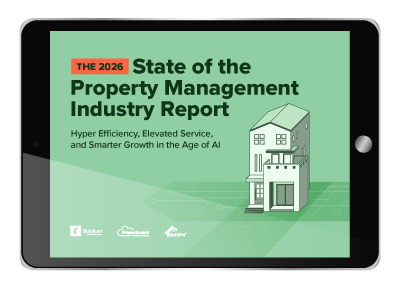Michigan Rental Market Trends in 2025
Michigan is a state with a comeback story. The state shed jobs and residents during economic recessions in the 1980s and late 2000s, and also endured the decline of manufacturing in the U.S. However, since 2021, Michigan has been experiencing modest population growth, according to the Census Bureau. It now has over 10 million residents, who primarily live in the southern half of the state’s Lower Peninsula, where all of the cities on this list of the best rental markets in Michigan are located.
What’s driving this growth? Michigan boasts a lower cost of living than many other places in the U.S., attracting residents from other states as well as other countries over the last few years. It also has a strong and increasingly diverse economy, with big-name companies like General Motors, Ford, Whirlpool, Kellogg’s, Rocket Mortgage, and Domino’s Pizza headquartered in the state.
Here’s what real estate investors and property managers should know about Michigan rental market trends in 2025:
- Urban revitalization: Cities that were formerly in decline, such as Detroit, have experienced significant revitalization in recent years.
- The housing shortage: A shortage of homes is driving up rent prices, though they remain more affordable than in much of the rest of the U.S.
- Long-term growth: Though the population is growing modestly at present, an aging population may lead to population decline in the long term.
If you’re looking to expand your real estate portfolio or property management services within Michigan, this post will guide you through evaluating 5 up-and-coming real estate markets there. We’ll share rental market statistics for each city, including inventory growth, rent growth, vacancy rates, cap rates, and property price appreciation. We’ll also highlight economic and demographic trends in each market.
Top 5 Rental Markets in Michigan for 2025
Without further ado, here are 5 Michigan rental markets where our research indicates growth opportunities lie in 2025.

Market #1: Lansing, MI
Lansing is the capital of Michigan and the third-largest metro area in the state, with 473,177 residents at present. It’s located in the southern half of the Lower Peninsula, roughly halfway between Detroit and Grand Rapids.
One of Lansing’s standout features is its educational sector. The city is home to several colleges and universities, with Michigan State University in East Lansing being the most prominent. MSU not only attracts students from across the globe, but also serves as a major employer in the region. Other significant employers include the Michigan state government as well as General Motors, which is headquartered in Detroit but has several facilities in Lansing.
Lansing offers a variety of cultural and recreational activities that enhance the quality of life for its residents, from museums like the Michigan History Museum and R.E. Olds Transportation Museum to the Potter Park Zoo. Residents can also attend sports games, concerts, and other events at Michigan State University.
Lansing ranked in position #47 on our 2025 list of up-and-coming real estate markets due to its moderately strong multifamily cap rates and asking rent growth over the last two years. It also appeared in the top 30 on two installments of the Wall Street Journal and Realtor.com’s quarterly real estate market rankings in 2024. However, despite the market’s potential, home prices remain relatively low, making it an attractive option for investors.
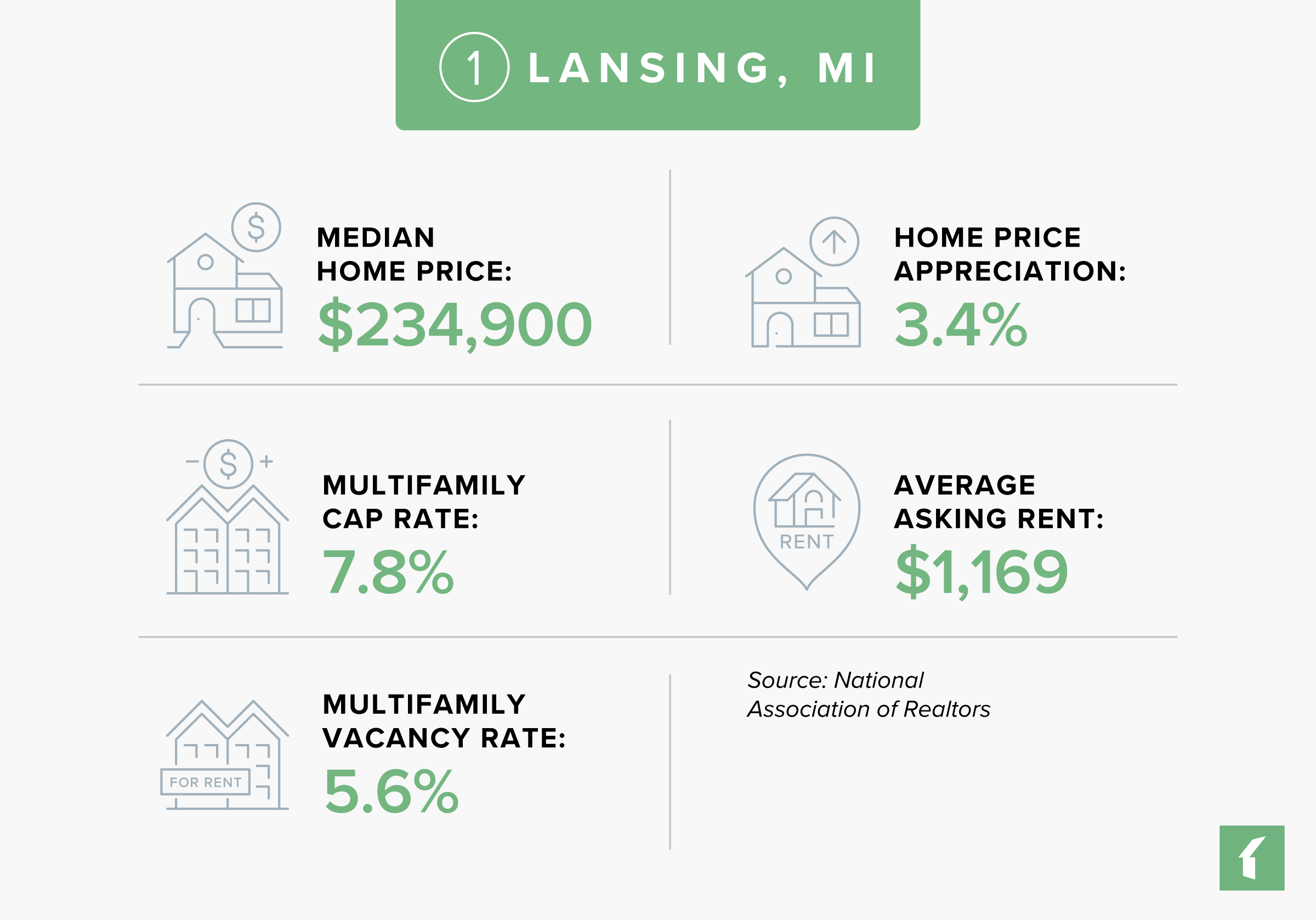
Lansing, Michigan Rental Market Statistics
- Rental Inventory (Q3-’24): 31,675
- Units Added Since Q3-’23: 0
- Asking Rent Growth Since Q3-’23: 3.8%
- Asking Rent (Q3-’24): $1,169
- Effective Rent (Q3-’24): $1,158
- Multifamily Vacancy Rate (Q3-’24): 5.6%
- Multifamily Cap Rate (Q3-’24): 7.8%
Source: National Association of Realtors
Lansing, Michigan Housing Market Statistics
- Median Home Price (Q3-’24): $234,900
- Home Price Appreciation Since Q3-’23: 3.4%
Source: National Association of Realtors
Lansing, Michigan Economic Statistics
- Population Growth (2023): -12.5%
- GDP Growth (2023): 7.7%
- Job Growth (Q3-’24): 2.3%
Source: National Association of Realtors
Lists That Mention Lansing, Michigan
- Emerging Housing Markets Index – Winter 2024 (WSJ/Realtor.com): #40
- Emerging Housing Markets Index – Spring 2024 (WSJ/Realtor.com): #20
- Best Real Estate Markets – Small Cities (WalletHub): #69
- Best Places to Live (U.S. News): #104
Market #2: Kalamazoo, MI
The Kalamazoo-Portage metro area has 262,215 residents, making it the smallest city on our list of the best rental markets in Michigan. It’s located in the southwestern part of the state. Despite its small size, it’s well connected to cities like Detroit and Chicago by road and rail.
Kalamazoo is home to three colleges and universities: Western Michigan University, Kalamazoo College, and Kalamazoo Valley Community College. These educational institutions bring young people to the area and contribute to the city’s cultural scene.
Cultural points of interest include the Kalamazoo Institute of the Arts, the Kalamazoo Valley Museum, and the Air Zoo Aerospace & Science Museum. With the city being located alongside a river, the Kalamazoo River Valley Trail offers residents 22 miles of scenic views as well as opportunities to walk and bike. The Kalamazoo Nature Center is another recreational destination in the city.
Kalamazoo is also home to one of the first outdoor pedestrian malls in the U.S., the Kalamazoo Mall, which provides a variety of shopping and dining options.
Kalamazoo ranked in the 59th position on our 2025 list of up-and-coming real estate markets, primarily due to its moderately strong multifamily cap rates, vacancy rates, and home price appreciation over the last two years. It also appeared on the Wall Street Journal and Realtor.com’s rankings of emerging housing markets for three quarters in 2024. As with other rental markets in Michigan, investors will find a relatively low cost of entry in Kalamazoo.
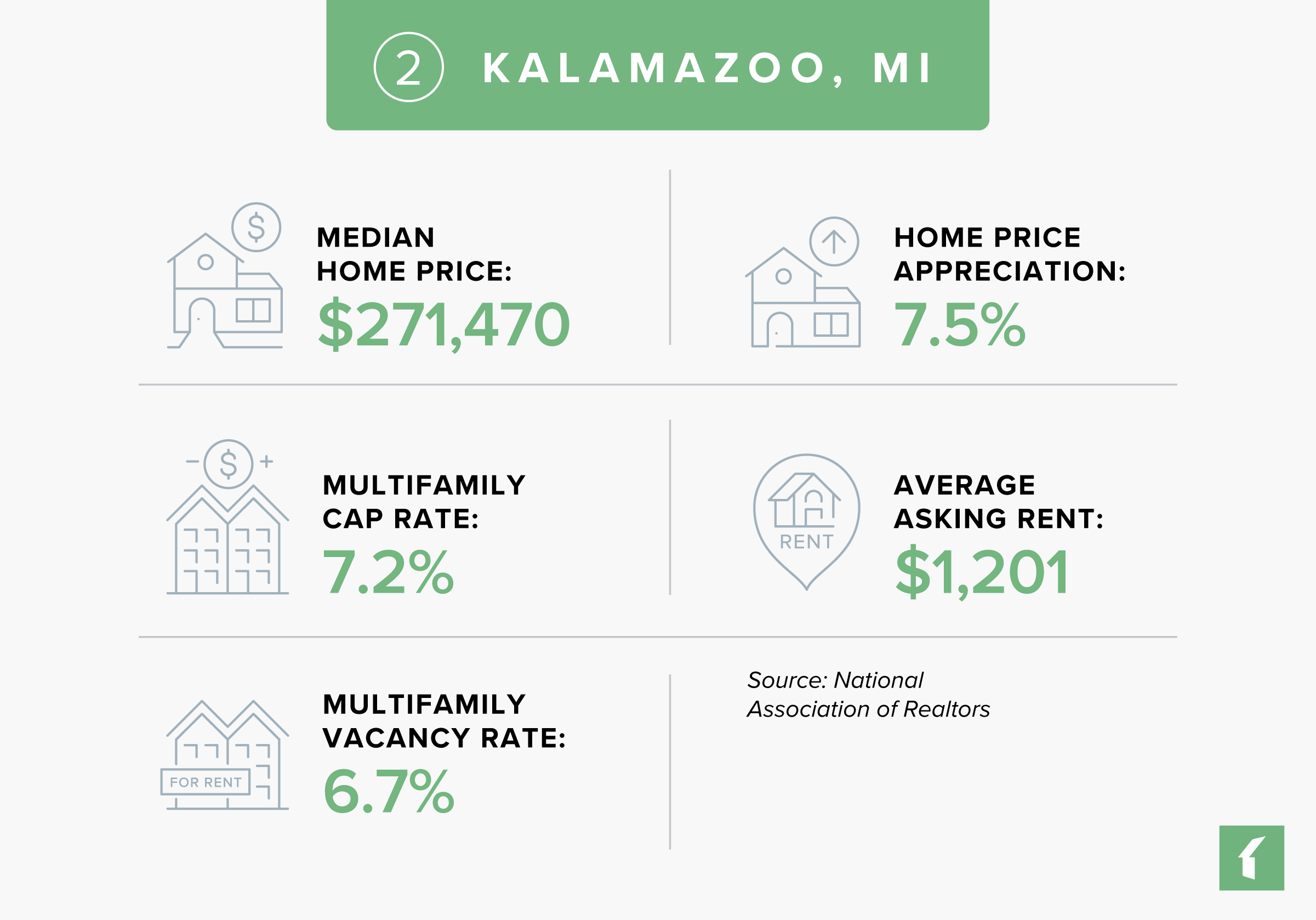
Kalamazoo, Michigan Rental Market Statistics
- Rental Inventory (Q3-’24): 19,634
- Units Added Since Q3-’23: 0
- Asking Rent Growth Since Q3-’23: 3.0%
- Asking Rent (Q3-’24): $1,201
- Effective Rent (Q3-’24): $1,191
- Multifamily Vacancy Rate (Q3-’24): 6.7%
- Multifamily Cap Rate (Q3-’24): 7.2%
Source: National Association of Realtors
Kalamazoo, Michigan Housing Market Statistics
- Median Home Price (Q3-’24): $271,470
- Home Price Appreciation Since Q3-’23: 7.5%
Source: National Association of Realtors
Kalamazoo, Michigan Economic Statistics
- Population Growth (2023): 0.4%
- GDP Growth (2023): 7.4%
- Job Growth (Q3-’24): -0.9%
Source: National Association of Realtors
Lists That Mention Kalamazoo, Michigan
- Emerging Housing Markets Index – Winter 2024 (WSJ/Realtor.com): #106
- Emerging Housing Markets Index – Spring 2024 (WSJ/Realtor.com): #23
- Emerging Housing Markets Index – Summer 2024 (WSJ/Realtor.com): #14
- Emerging Housing Markets Index – Fall 2024 (WSJ/Realtor.com): #5
- Best Places to Live (U.S. News): #90
Market #3: Grand Rapids, MI
The Grand Rapids, Michigan metro area is home to 1,162,950 residents. The city is located on the western side of the state, approximately two and a half hours from Detroit and three hours from Chicago. Named for its position alongside the Grand River, Grand Rapids has also been known as Furniture City due to its long history of furniture manufacturing.
Today, Grand Rapids has a diverse economy, with companies representing the healthcare, information technology, automotive, and manufacturing sectors all present in Grand Rapids. The city’s top employers include Corewell Health, Meijer, and Trinity Health. Two higher education institutions, Grand Valley State University and Calvin University, are also located here.
The city has a vibrant cultural scene as well, with the Grand Rapids Art Museum and the Frederik Meijer Gardens & Sculpture Park being two well-known destinations when it comes to the arts. The Gerald R. Ford Presidential Museum is also in Grand Rapids, where the former president’s childhood home is located.
The John Ball Zoo and Millennium Park are popular among those seeking outdoor recreation opportunities, as well as the Grand River, which offers opportunities for kayaking and fishing. Residents of Grand Rapids also enjoy its multitude of craft breweries.
Grand Rapids has made our list of up-and-coming real estate markets in past years due to its strong economy and rental market, though it just missed the cut in 2025. It performed moderately well against other U.S. cities on measures of asking rent growth, multifamily vacancy rates, and home price appreciation over the past two years. However, properties are more expensive here than in some of the other Michigan real estate markets on our list, pushing cap rates down slightly. Still, Grand Rapids presents opportunities for investors due to its strong rental demand from professionals attracted to the city’s strong economy.
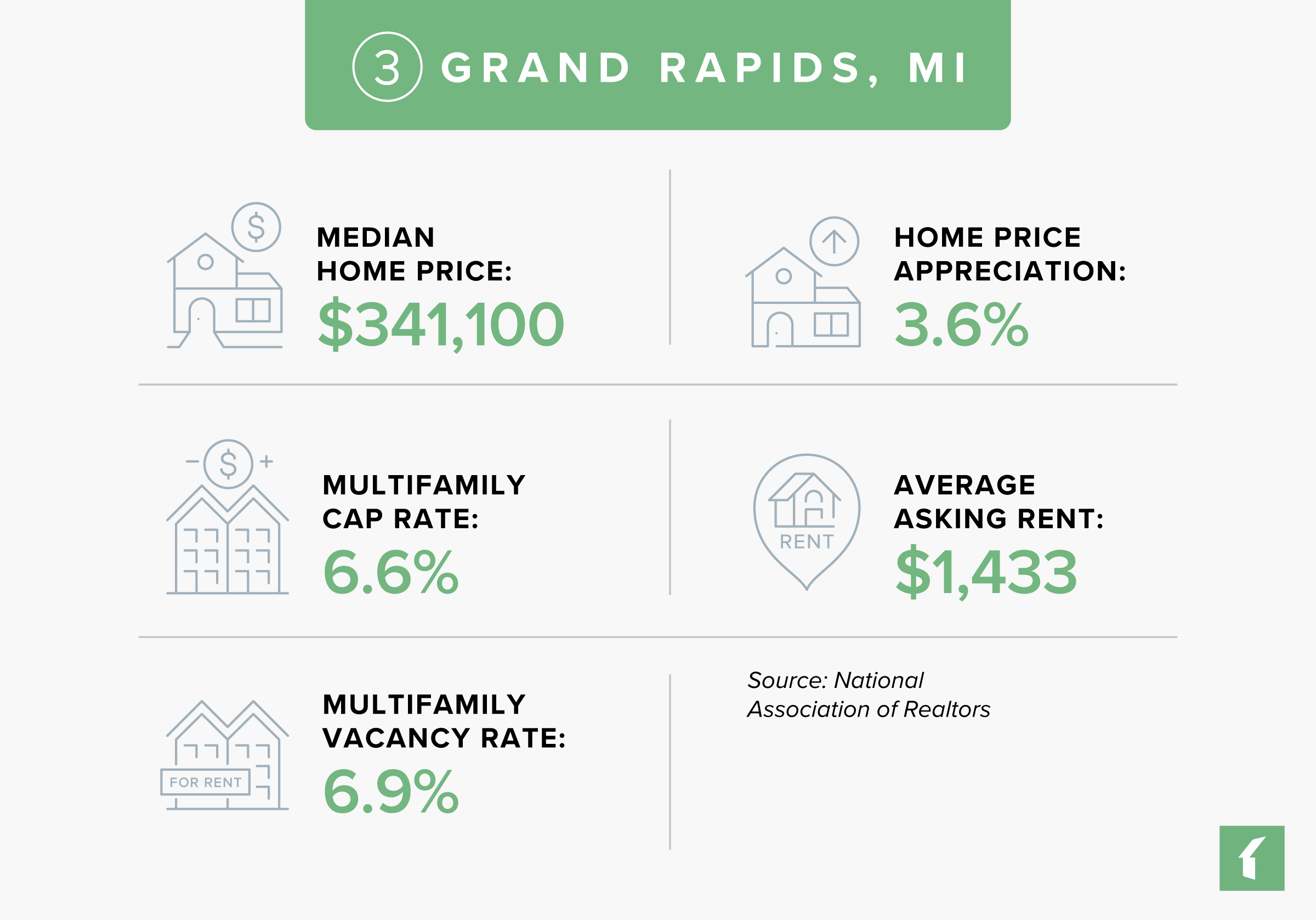
Grand Rapids, Michigan Rental Market Statistics
- Rental Inventory (Q3-’24): 53,717
- Units Added Since Q3-’23: +156
- Asking Rent Growth Since Q3-’23: 3.4%
- Asking Rent (Q3-’24): $1,433
- Effective Rent (Q3-’24): $1,422
- Multifamily Vacancy Rate (Q3-’24): 6.9%
- Multifamily Cap Rate (Q3-’24): 6.6%
Source: National Association of Realtors
Grand Rapids, Michigan Housing Market Statistics
- Median Home Price (Q3-’24): $341,100
- Home Price Appreciation Since Q3-’23: 3.6%
Source: National Association of Realtors
Grand Rapids, Michigan Economic Statistics
- Population Growth (2023): 6.3%
- GDP Growth (2023): 7.2%
- Job Growth (Q3-’24): 0.7%
Source: National Association of Realtors
Lists That Mention Grand Rapids, Michigan
- Emerging Housing Markets Index – Winter 2024 (WSJ/Realtor.com): #66
- Emerging Housing Markets Index – Spring 2024 (WSJ/Realtor.com): #29
- Best Real Estate Markets – Mid-Sized Cities (WalletHub): #25
- Best Places to Live (U.S. News): #45
Market #4: Ann Arbor, MI
Located less than an hour outside of Detroit, Ann Arbor is located in the southeastern part of the state. Ann Arbor is a quintessential college town, with the University of Michigan located here.
Many of the metro area’s 365,536 residents are employed by the university and its health system. Other top employers in the area are also in the healthcare and educational sectors, including Trinity Health Michigan, Ann Arbor Public Schools, and the VA Ann Arbor Healthcare System. In addition, numerous technology companies have sprung up in Ann Arbor due to research and development opportunities stemming from the University of Michigan and its graduates.
Ann Arbor consistently ranks among the best places to live in the U.S. Nicknamed “Tree Town,” the city has an abundance of parks, with a few of the most popular being Nichols Arboretum, Buhr Park, Matthaei Botanical Gardens, and Gallup Park. Residents also enjoy the metro’s numerous festivals, museums, galleries, theaters, and restaurants, which contribute to its culture and strong sense of community.
Ann Arbor didn’t make it onto our list of up-and-coming real estate markets in 2025 due to its slower economic and population growth in comparison with other markets we analyzed. However, the Wall Street Journal and Realtor.com selected the city as one of the best housing markets in the country in all four quarters of 2024. Ann Arbor’s rental market also showed moderately strong multifamily vacancy rates, rent growth, cap rates, and home price appreciation throughout 2023 and 2024. Though properties cost more in Ann Arbor than in the other Michigan rental markets on our list, strong rental demand from students, graduates, and employees of the University of Michigan will continue to attract investors to this bustling metro area.
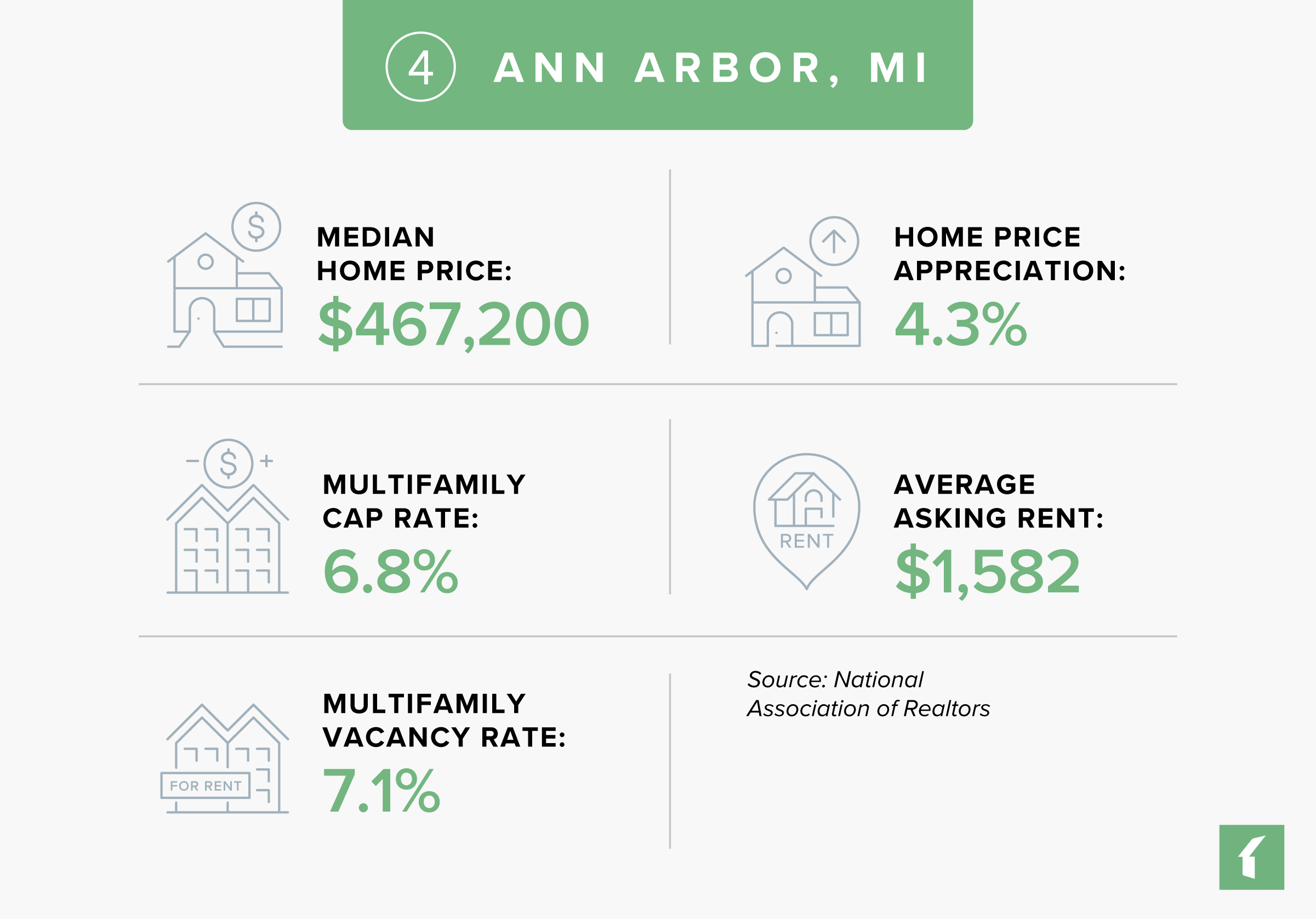
Ann Arbor, Michigan Rental Market Statistics
- Rental Inventory (Q3-’24): 32,166
- Units Added Since Q3-’23: +668
- Asking Rent Growth Since Q3-’23: 1.6%
- Asking Rent (Q3-’24): $1,582
- Effective Rent (Q3-’24): $1,565
- Multifamily Vacancy Rate (Q3-’24): 7.1%
- Multifamily Cap Rate (Q3-’24): 6.8%
Source: National Association of Realtors
Ann Arbor, Michigan Housing Market Statistics
- Median Home Price (Q3-’24): $467,200
- Home Price Appreciation Since Q3-’23: 4.3%
Source: National Association of Realtors
Ann Arbor, Michigan Economic Statistics
- Population Growth (2023): -0.2%
- GDP Growth (2023): 7.2%
- Job Growth (Q3-’24): 0.7%
Source: National Association of Realtors
Lists That Mention Ann Arbor, Michigan
- Emerging Housing Markets Index – Winter 2024 (WSJ/Realtor.com): #37
- Emerging Housing Markets Index – Spring 2024 (WSJ/Realtor.com): #3
- Emerging Housing Markets Index – Summer 2024 (WSJ/Realtor.com): #9
- Emerging Housing Markets Index – Fall 2024 (WSJ/Realtor.com): #9
- Best Real Estate Markets – Small Cities (WalletHub): #32
- Best Places to Live (U.S. News): #19
Market #5: Detroit, MI
With 4,342,304 residents living in its metro area, Detroit is the largest city in Michigan, located on the U.S. border with Canada. The city’s population has declined significantly since Detroit’s peak in 1950 due to suburbanization, industrial restructuring, and economic challenges over the decades. However, in recent years, Detroit has begun to gain residents once again, albeit at a slow pace. This renewed growth has been due to numerous economic investments and revitalization efforts in the city, resulting in improved conditions (such as increased employment and decreased crime) that have helped Detroit hold onto its residents and gain new ones.
Detroit, famously known as “Motor City,” has long been considered the epicenter of the American auto industry, with the “Big Three” automakers—General Motors, Ford, and Stellantis—all anchored in the Detroit metro area. Beyond these automotive giants, top employers in the city include Detroit Medical Center, the city of Detroit, Rocket Mortgage, and the Henry Ford Health System. Detroit’s growing tech sector features companies like Duo Security and Rivian. Additionally, Wayne State University, a prominent educational institution in the city, is a leading employer in Detroit.
Residents of Detroit are drawn to the city’s affordable housing prices and diverse culture. They enjoy exploring historical and entertainment landmarks such as the Motown Museum, the Charles H. Wright Museum of African American History, the Detroit Institute of the Arts, and Fox Theatre. Outdoor enthusiasts appreciate the scenic Detroit Riverwalk and Belle Isle Park. Sports fans can catch a game at Comerica Park or Little Caesars Arena. And popular festivals like the Detroit Jazz Festival and the Movement Electronic Music Festival draw thousands of attendees each year.
Detroit offers some of the most affordable real estate in the country, and cap rates for multifamily rental properties have been moderately strong over the last two years. Though it didn’t make our list of up-and-coming real estate markets in 2025 due to its slow population and job growth, it’s worth noting that Detroit was highlighted as an emerging housing market by the Wall Street Journal and Realtor.com in three out of four quarters in 2024. When investing in Detroit, it’s important to weigh the potential for returns against the risks unique to the area, including tenant quality challenges, elevated crime rates, and a preponderance of vacant homes. As such, choosing the right property in the right neighborhood is even more important in Detroit than it may be elsewhere.
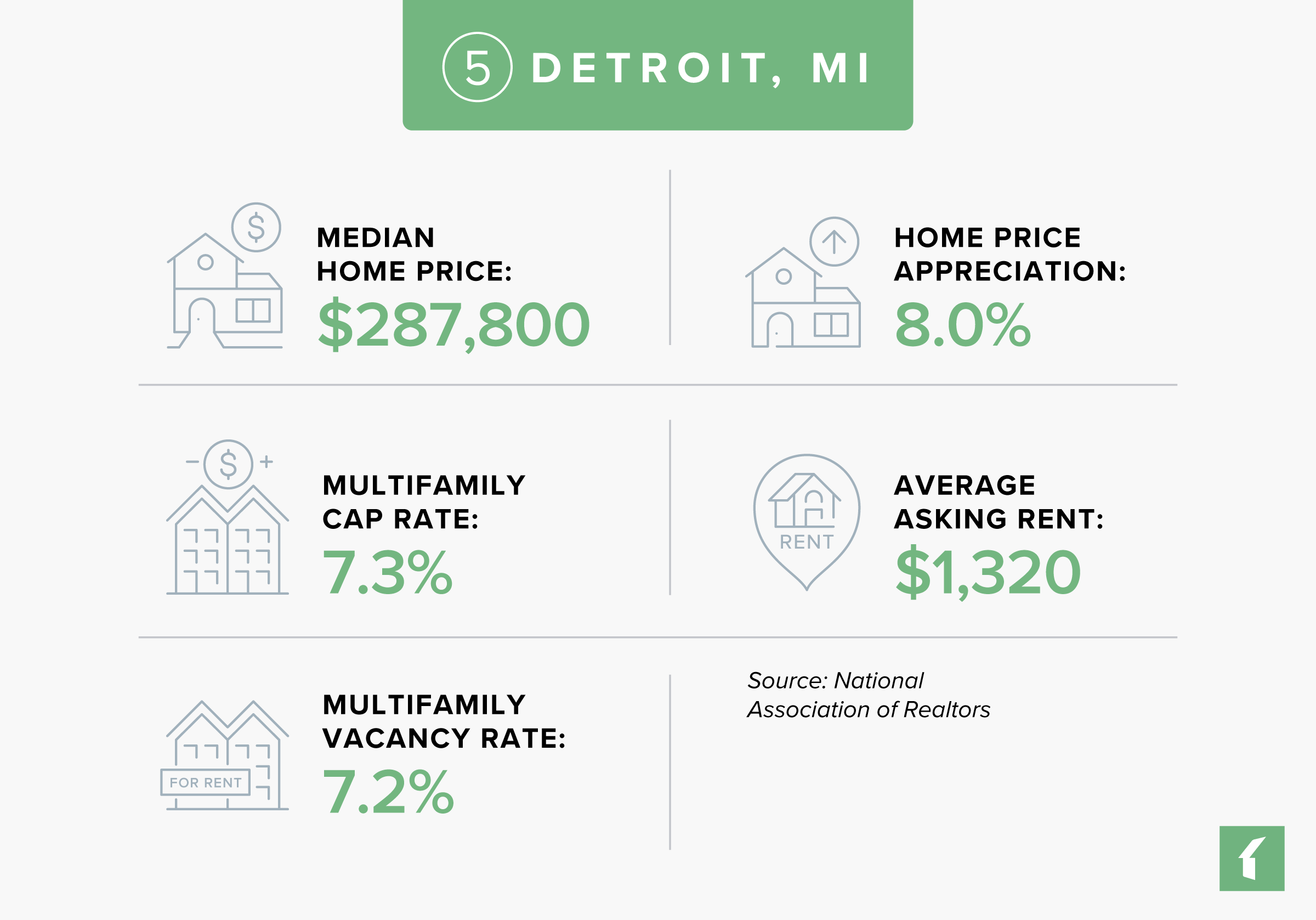
Detroit, Michigan Rental Market Statistics
- Rental Inventory (Q3-’24): 231,488
- Units Added Since Q3-’23: +356
- Asking Rent Growth Since Q3-’23: 3.5%
- Asking Rent (Q3-’24): $1,320
- Effective Rent (Q3-’24): $1,311
- Multifamily Vacancy Rate (Q3-’24): 7.2%
- Multifamily Cap Rate (Q3-’24): 7.3%
Source: National Association of Realtors
Detroit, Michigan Housing Market Statistics
- Median Home Price (Q3-’24): $287,800
- Home Price Appreciation Since Q3-’23: 8.0%
Source: National Association of Realtors
Detroit, Michigan Economic Statistics
- Population Growth (2023): -0.1%
- GDP Growth (2023): 7.6%
- Job Growth (Q3-’24): 0.6%
Source: National Association of Realtors
Lists That Mention Detroit, Michigan
- Emerging Housing Markets Index – Winter 2024 (WSJ/Realtor.com): #135
- Emerging Housing Markets Index – Spring 2024 (WSJ/Realtor.com): #72
- Overall Real Estate Prospects (PwC/ULI): #17
- Best Real Estate Markets – Large Cities (WalletHub): #58
- Best Places to Live (U.S. News): #149
How Do We Identify the Best Rental Markets in Michigan?
We use the following sources to help us ascertain the best rental markets in the U.S. across five different categories.
Industry Indicators
Measures of opportunity for rental property investors and property managers:
- Markets with the best overall real estate investment prospects, as measured by PwC and the Urban Land Institute
- Housing markets with emerging investment opportunities, as measured by the Wall Street Journal and Realtor.com
- Markets with a greater number of renters relative to homeowners, as measured by the National Association of Realtors
- Markets with a high rate of renter household formation, as measured by the National Association of Realtors
Housing Indicators
Measures of property prices and rent growth:
- Markets with the highest growth in asking rents, as measured by the National Association of Realtors
- Markets with the lowest rental property vacancy rate, as measured by the National Association of Realtors
- Markets with the highest rental property cap rates, as measured by the National Association of Realtors
- Markets with the most home price appreciation, as measured by the National Association of Realtors
- Markets with affordable monthly mortgage payments relative to income, as measured by the National Association of Realtors
Economic and Job Market Indicators
Measures of employment growth:
- Markets with the lowest unemployment rates, as measured by the National Association of Realtors
- Markets with the most employment growth, as measured by the National Association of Realtors
- Markets with the most GDP growth, as measured by the National Association of Realtors
- States with the most economic activity, as measured by the National Association of Realtors
Demographic Indicators
Measures of population growth:
- Markets with the greatest population growth, as measured by the National Association of Realtors
- The fastest-growing real estate markets, as measured by U.S. News
- The best places to live, based on analyses of quality of life and desirability, as measured by U.S. News
Climate Indicators
Measures of climate vulnerability:
- Markets with the lowest risk of natural disasters and extreme conditions, as measured by the Federal Emergency Management Agency
60 Up-and-Coming Real Estate Markets in 2025
In Buildium’s annual Up-and-Coming Real Estate Markets list, we analyzed 175 metro areas across the U.S. to determine which cities show promise for rental investors and property managers in the year ahead. Wondering where else can rental investors and property managers find more growth opportunities in 2025? View the full list of emerging markets we’ve identified across the country.
Read more on Industry Research